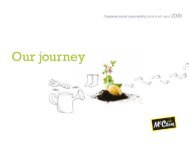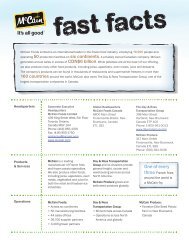From the Ground Up - McCain Foods Limited
From the Ground Up - McCain Foods Limited
From the Ground Up - McCain Foods Limited
Create successful ePaper yourself
Turn your PDF publications into a flip-book with our unique Google optimized e-Paper software.
Manual harvesting and<br />
bagging seed potatoes in<br />
a field near Balcarce.<br />
certain level of water content, you irrigate,” explains Pelletier. “That was my apprenticeship<br />
in <strong>the</strong> science of irrigation.”<br />
<strong>From</strong> Nebraska, Pelletier moved on to O<strong>the</strong>llo, Washington, where <strong>McCain</strong> did<br />
have a factory. One day, he received a phone call from Wallace. He said, “Ghislain,<br />
when you and I talked last year, you told me you wanted to see <strong>the</strong> world. Well, I have<br />
something for you today.”<br />
Pelletier asked, “Where?”<br />
Wallace replied, “Argentina. You talk to your wife tonight and give me a call tomorrow.”<br />
Pelletier, eager for travel, accepted <strong>the</strong> assignment. His task would be to report<br />
on where <strong>McCain</strong> should locate a South American plant. First, Pelletier went to<br />
Florenceville to be briefed by Bob Coston, an executive who had been hired from<br />
Nestlé to manage <strong>the</strong> South America program in its initial stages, and by Tony van<br />
Leersum, who had years of experience in South America. Then <strong>the</strong> Pelletier family,<br />
with eleven suitcases and a couple of Spanish dictionaries, left for Argentina.<br />
He wasn’t <strong>the</strong> first <strong>McCain</strong> employee to explore South America. George<br />
McClure had investigated <strong>the</strong> business and economic environment of <strong>the</strong> continent,<br />
assisted by Don Young, who looked at <strong>the</strong> agricultural side. Also, <strong>McCain</strong><br />
Produce for some years had barter arrangements with South American companies<br />
in which it exchanged seed potatoes for fresh fruit and vegetables. As for Van<br />
Leersum, he had travelled <strong>the</strong>re on sales trips when working for a Dutch company<br />
before joining <strong>McCain</strong>. He was acquainted with some South American growers,<br />
including <strong>the</strong> largest farm co-operative in Brazil. Both Van Leersum and <strong>McCain</strong><br />
agronomist Han van den Hoek had made many trips to Brazil and Argentina to<br />
help McDonald’s obtain better fresh potatoes when <strong>the</strong> chain was still producing<br />
fries in its restaurants.<br />
The issue for <strong>McCain</strong> was which of <strong>the</strong> two major markets in South America to<br />
choose as <strong>the</strong> site for a plant: Brazil or Argentina. McDonald’s favoured Brazil because<br />
it has more customers – a population of 180 million, compared with Argentina’s<br />
40 million. The consensus of <strong>McCain</strong>’s experts, including Pelletier, was that Brazil is<br />
a better place for growing oranges than potatoes. The climate is too hot for potatoes,<br />
<strong>the</strong>re are more pests, and <strong>the</strong> yields aren’t as good as those of Argentina, which has<br />
better soil conditions and cooler nights.<br />
<strong>McCain</strong> settled on Balcarce, a city of forty thousand people about five hundred<br />
kilometres south of Buenos Aires, as <strong>the</strong> site for its new plant. Not only is Balcarce on<br />
<strong>the</strong> outer circle of <strong>the</strong> area Pelletier had identified as good potato-growing country,<br />
it has an agriculture faculty. “The city is home to many agronomists,” says Pelletier.<br />
“Even <strong>the</strong> mayor is an agronomist.”<br />
Pelletier hired local talent to work on <strong>McCain</strong>’s agricultural program, which involved<br />
visiting growers and persuading <strong>the</strong>m to grow good processing potatoes.<br />
Gustavo Scioli, one of <strong>the</strong> agronomists hired, was <strong>the</strong> son of a local grower.<br />
The most popular locally grown variety was <strong>the</strong> Spunta, a high-yielding table potato<br />
that isn’t much good for processing. “It’s a bag of water,” says Pelletier. He encouraged<br />
<strong>the</strong> farmers to grow <strong>the</strong> Shepody and Russet Burbank varieties and ran trials<br />
with <strong>the</strong> help of <strong>the</strong> local research station. Then he began recruiting growers to work<br />
with <strong>McCain</strong>. By <strong>the</strong> time he left, in 1996, <strong>McCain</strong> was processing <strong>the</strong> second crop in<br />
its new factory. The first year, <strong>McCain</strong> bought twenty thousand metric tons of local<br />
potatoes and, in <strong>the</strong> second year, twice that amount.<br />
198 <strong>From</strong> <strong>the</strong> GrouN d up<br />
New w orlds to CoN quer 199<br />
tOP lEFt: Unloading fiftykilogram<br />
bags of potatoes at<br />
<strong>the</strong> Balcarce plant during <strong>the</strong><br />
Argentina plant’s early years.<br />
tOP RIGHt: Bulk body trucks<br />
are now used to transport<br />
potatoes from <strong>the</strong> fields to<br />
<strong>the</strong> storage facilities.<br />
BOttOM: Grower Sergio<br />
Scioli and Ghislain Pelletier,<br />
1995.






